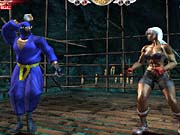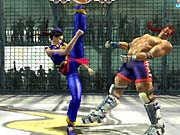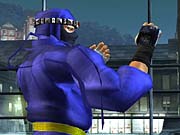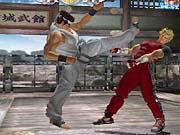First impressionsVirtua Fighter 4 on the PS2
Find out how the home conversion of Sega's stunning arcade fighter is shaping up.
Sega finally unveiled the first playable version of Virtua Fighter 4 for the PlayStation 2. We were able to check out the game and came away impressed with what we saw. While not final, the build of the game we saw showcased slick visuals that were nearly arcade-perfect. Best of all, and most importantly for a fighting game, the PS2 version of the game featured rock-solid gameplay.

For those who haven't found it in their local arcade, Virtua Fighter 4 is the latest installment in Sega's flagship fighting series. Since its arcade debut in 1993, the Virtua Fighter series has driven the development of arcade technology and the evolution of the 3D fighting genre. Given the ambitious technology used for the arcade games, home conversions of the series have had to find creative solutions for re-creating the games at home.
Not surprisingly, one of the biggest challenges in bringing Virtua Fighter 4 to the PS2 lies in re-creating the game's graphics. The arcade version of Virtua Fighter 4 was developed on Sega's Naomi 2 arcade board and features beautifully detailed, polygon intensive graphics and a hefty dose of lighting. The texture work--not something the PS2 has been known for to date--is varied and has a great deal of fine detail. In addition, the game features a great deal of geometry on display in the island stage's deformable sand, the castle stage's snow, and the temple stage's breakable floor tiles. Despite the PlayStation 2's considerable graphical prowess, there was concern as to whether or not it was up to the task of replicating the arcade game's visuals.

While the past year has seen the phrase "the power of the PlayStation 2" thrown around quite a bit, Virtua Fighter 4 on PS2 actually makes a compelling case for the console's muscle, even in its early state. Despite the fact that the game has only been in development for a short time, developer AM2 has managed to coax impressive performance out of the PS2 hardware for its first project. The game already comes incredibly close to the arcade version's graphics, and it definitely makes the most of the PS2 hardware.
We did a double take when we first saw the game running. At first glance, it bears an uncanny resemblance to its arcade counterpart. In fact, even after we started noticing the little details that gave away the fact it was running on a PS2, the game looked very impressive. Before we begin to wax poetic on the game's graphics, we should point out the spots we've seen so far that keep the graphics from being 100-percent arcade-perfect. There are some aliasing issues, resulting in jagginess, shimmer, and moiré weirdness in places. There's nothing on the level of the Japanese versions of Tekken Tag or DOA at the PS2's launch, but it's noticeable if you're looking for it. The lighting in the game has been reworked to accommodate the PS2 hardware and isn't quite as dramatic as it is in the arcade version. The aforementioned sand and snow have both been scaled back and don't deform as much as they do in the arcade. Finally, some of the background elements off in the distance have been swapped out with 2D bitmaps.
While you'll have to scrutinize the game to find the graphical quirks we've mentioned, the game's strengths are far more apparent. The game manages to retain the high level of detail that the arcade version boasts. The stages and characters are modeled with an extremely generous amount of polygons and feature some of the cleanest, most detailed textures seen on the PS2. The game's 13 fighters--11 returning characters from Virtua Fighter 3 and two new characters--are all beautifully rendered, featuring moving hair, animated clothing, eye tracking, and lip synching. The cast is showcased via dramatic camera angles during certain throws in the gameplay and close-ups during their poses after you've won a match.

The stages in the game are also highly detailed, offering incredibly detailed vistas that are shown in the game's dynamic fly-through of a stage before a fight begins. In the actual fighting ring, you'll find a basic square area to duke it out in. In some cases, you'll find deformable objects such as the breakable floor tiles in new character Lei Fei's temple stage, the sand in Jeffrey's island stage, or the snow in Lion's castle stage. On top of that, you'll find that many stages use a variety of lighting effects that add to the atmosphere of the area you'll fight in. The bright sunlight that causes lens flare while fighting on the temple stage is contrasted by the diffuse lighting that filters down to the ocean-floor aquarium stage. What looks to be a new stage in the versus mode has you fighting in a ring filled with calf-high water, and it sported some well-done water effects. Finally, a bit of intentional fog has been inserted in places to add a bit more visual variety. In spite of the processor-intensive graphics, Virtua Fighter 4 manages to keep all the action going onscreen at a smooth 60 frames per second.

As nice as the graphics are, the gameplay surpasses them in terms of quality thanks to very tight control and a deep gameplay system. While we're unsure exactly which version of Virtua Fighter 4 the PS2 game is based on at the moment--since the arcade game first debuted earlier this year in Japan it's already received an update and there's rumors of a third--we expect that it's likely to be the latest one, version B, given how some of the characters are balanced. In terms of control, Virtua Fighter 4 handles like a dream once you accustom yourself to the game's timing and button configuration. The timing in the early build we played seemed to be off by a hair, which required us to adjust our play style in order to be effective. The fact that it was so easy to adjust to gives us hope that the final version of the game will feel just right. As far as the button layout goes, the default setup in which you block with the square button, punch with triangle, and kick with circle took a bit of getting used to, depending on the button presses for your player's moves. Fortunately, you'll be able to map the buttons any way you like on the PS2 controller in the options menu. Moving your character in the ring with the D-pad and circling your opponent in 3D by double-tapping and then holding up or down were easier to pick up. With a bit of practice, the game will be old hat to fighting vets.
You'll find five gameplay modes to test your skills in: arcade, versus, kumite, AI system, and training. The arcade, versus, and kumite modes are on tap to offer some hefty challenges, and the training and AI system modes are on hand to allow you to brush up on your fighting skills and customize your character. While specific details are a bit thin at the moment, it looks as though the game will also employ a variation on the magnetic card system incorporated into the Japanese arcade versions of Virtua Fighter 4. The cards are inserted into a slot in the arcade unit and let you save your character and ranking. The system allows the two players to see how skilled they both are by displaying their win-loss records. However, the biggest appeal of the magnetic card system, besides bragging rights, is that by winning fights in succession, you are able to unlock new items for use in the game. You can customize your character's appearance with a wide variety of items ranging from blue rabbits to clothing accessories. A plainly attired fighter taking on an opponent decked out like a Mardi Gras float would just be asking for trouble. While we couldn't get details out of Sega as to exactly how the card system will be implemented in the PS2 version of the game, we suspect that the game will use a PS2 memory card as a substitute for the cards used in Japanese arcades and allow players to open secrets in the game. We're fairly certain the feature will be included in some fashion, as the special items are definitely in the game--we played a few matches against Lion in the kumite mode, and he was wearing a glossy motorcycle helmet, which is one of his unlockable items.

So far, Virtua Fighter 4 for the PS2 is coming along incredibly well. Even though the early build we played had a few quirks, the game already looks and plays extremely well. With the game expected to release in the latter end of this quarter in the US, AM2 should have ample time to polish and tune the game. Barring some massive calamity, the game looks to be the finest home conversion of a Virtua Fighter game yet. Look for a more in-depth preview of the game in the coming weeks.
Got a news tip or want to contact us directly? Email news@gamespot.com
Join the conversation